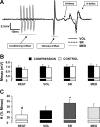Effects of a compression garment on sensory feedback transmission in the human upper limb
- PMID: 29641310
- PMCID: PMC6093963
- DOI: 10.1152/jn.00581.2017
Effects of a compression garment on sensory feedback transmission in the human upper limb
Abstract
Compression apparel is popular in both medical and sport performance settings. Perceived benefits are suggested to include changes in sensory feedback transmission caused by activation of mechanoreceptors. However, little is known about effects of compression apparel on sensorimotor control. Our purpose was to mechanistically examine whether compression apparel modulates sensory feedback transmission and reaching accuracy in the upper limb. Two experiments were completed under CONTROL and COMPRESSION (sleeve applied across the elbow joint) conditions. M-waves and H-reflexes were elicited by stimulating the median nerve and were recorded via surface electromyography (EMG). In experiment 1, H-reflexes and M-H recruitment curves were assessed at REST, during wrist flexion (10% EMGmax), and during a cutaneous conditioning of the superficial radial (SR) or distal median (MED) nerve. Cutaneous reflexes were elicited during 10% wrist flexion via stimulation of SR or MED. In experiment 2, unconditioned H-reflex measures were assessed at rest, during arm cycling, and during a discrete reaching task. Results indicate that compression apparel modulates spinal cord excitability across multiple sensory pathways and movement tasks. Interestingly, there was a significant improvement in reaching accuracy while wearing the compression sleeve. Taken together, the compression sleeve appears to increase precision and sensitivity around the joint where the sleeve is applied. Compression apparel may function as a "filter" of irrelevant mechanoreceptor information allowing for optimal task-related sensory information to enhance proprioception. NEW & NOTEWORTHY Wearing a customized compression sleeve was shown to alter the excitability of multiple pathways within the central nervous system regardless of conditioning input or movement task and was accompanied by improved accuracy of reaching movements and determination of movement end point. Compression apparel may assist as a type of "filter function" of tonic and nonspecific mechanoreceptor information leading to increased precision and movement sensitivity around the joint where compression is applied.
Keywords: H-reflex; afferent feedback; compression; conditioning; cutaneous; electromyography; proprioception.
Figures








Similar articles
-
Compression socks enhance sensory feedback to improve standing balance reactions and reflex control of walking.BMC Sports Sci Med Rehabil. 2021 Jun 2;13(1):61. doi: 10.1186/s13102-021-00284-2. BMC Sports Sci Med Rehabil. 2021. PMID: 34078449 Free PMC article.
-
Facilitation of soleus H-reflex amplitude evoked by cutaneous nerve stimulation at the wrist is not suppressed by rhythmic arm movement.Exp Brain Res. 2004 Dec;159(3):382-8. doi: 10.1007/s00221-004-2092-x. Epub 2004 Oct 8. Exp Brain Res. 2004. PMID: 15480593
-
Muscle fatigue changes cutaneous suppression of propriospinal drive to human upper limb muscles.J Physiol. 2007 Apr 1;580(Pt 1):211-23. doi: 10.1113/jphysiol.2006.125997. Epub 2007 Jan 11. J Physiol. 2007. PMID: 17218357 Free PMC article.
-
Sensory enhancement amplifies interlimb cutaneous reflexes in wrist extensor muscles.J Neurophysiol. 2019 Nov 1;122(5):2085-2094. doi: 10.1152/jn.00324.2019. Epub 2019 Sep 11. J Neurophysiol. 2019. PMID: 31509473 Free PMC article.
-
Contributions to the understanding of gait control.Dan Med J. 2014 Apr;61(4):B4823. Dan Med J. 2014. PMID: 24814597 Review.
Cited by
-
The effect of a combined compression-tactile stimulating sock on postural stability.Front Sports Act Living. 2024 Dec 16;6:1516182. doi: 10.3389/fspor.2024.1516182. eCollection 2024. Front Sports Act Living. 2024. PMID: 39736885 Free PMC article.
-
Effects of Compression Pants with Different Pressure Levels on Anaerobic Performance and Post-Exercise Physiological Recovery: Randomized Crossover Trial.Sensors (Basel). 2025 Aug 7;25(15):4875. doi: 10.3390/s25154875. Sensors (Basel). 2025. PMID: 40808038 Free PMC article.
-
The effect of compression and combined compression-tactile stimulation on lower limb somatosensory acuity.Front Sports Act Living. 2023 Oct 17;5:1235611. doi: 10.3389/fspor.2023.1235611. eCollection 2023. Front Sports Act Living. 2023. PMID: 37927453 Free PMC article.
-
Acute effects of wearing compression knee-length socks on ankle joint position sense in community-dwelling older adults.PLoS One. 2021 Feb 8;16(2):e0245979. doi: 10.1371/journal.pone.0245979. eCollection 2021. PLoS One. 2021. PMID: 33556067 Free PMC article.
-
Compression socks enhance sensory feedback to improve standing balance reactions and reflex control of walking.BMC Sports Sci Med Rehabil. 2021 Jun 2;13(1):61. doi: 10.1186/s13102-021-00284-2. BMC Sports Sci Med Rehabil. 2021. PMID: 34078449 Free PMC article.
References
-
- Berry MJ, McMurray RG. Effects of graduated compression stockings on blood lactate following an exhaustive bout of exercise. Am J Phys Med 66: 121–132, 1987. - PubMed
Publication types
MeSH terms
LinkOut - more resources
Full Text Sources
Other Literature Sources
Research Materials

